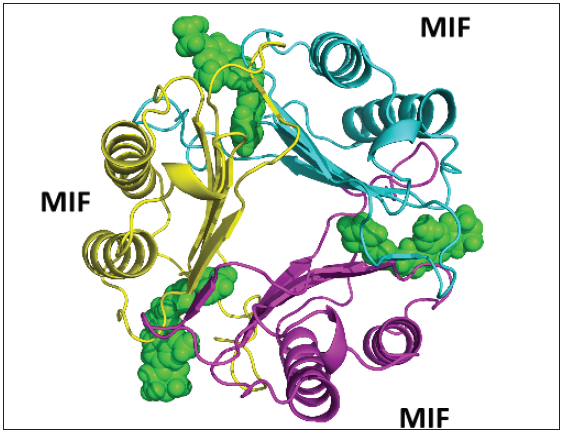Unveiling MIF: The hidden hero in cancer therapy’s evolution
* Corresponding author: Dr. Prithiviraj Nagarajan, Assistant Professor, Department of Medical Biotechnology, Aarupadai Veedu Medical College & Hospital, Vinayaka Mission’s Research Foundation (Deemed to be a University), Kirumampakkam, Puducherry, India. prithivinaga@gmail.com
-
Received: ,
Accepted: ,
How to cite this article: Nagarajan P. Unveiling MIF: The hidden hero in cancer therapy’s evolution. South Asian J Health Sci. 2024;1:53–4. doi: 10.25259/SAJHS_5_2023
Dear Editor,
The prospective therapeutic approach of targeting Macrophage Migration Inhibitory Factor (MIF) offers promise in inflammatory illnesses and cancer; Bloom, and David 1966, identified MIF as an inflammatory cytokine produced by T-cells.[1] This breakthrough marked a significant advancement in medical research, revealing MIF’s pivotal role in immunological responses, inflammatory processes, and disease progression.[2] This comprehensive study delves into the complex realm of MIF, shedding light on its significance in cancer pathophysiology, innate and acquired immunity, inflammatory diseases, and related areas.[3] This article scrutinizes recent strides in understanding MIF’s structural properties, enzymatic functions, and potential as a therapeutic target, mainly focusing on its prospects for therapeutic interventions.[4] Exploring personalised treatments aimed at regulating MIF, be it through small-molecule inhibitors or gene therapy, harbors the potential to revolutionise therapeutic approaches for a broad spectrum of MIF-associated disorders.[5] This narrative aims to elucidate the evolving landscape of MIF research, offering crucial insights into its therapeutic capabilities and its promising role in the future of precision medicine.[6]
MIF’s significance transcends its biological functions; X-ray crystallography and Nuclear Magnetic Resonance (NMR) methods have revealed its homo-trimeric composition [Figure 1],[6] with recent research highlighting the critical role of the carboxy-terminal region in maintaining both its structural integrity and enzymatic activity.[7]

- Illustrates the trimeric structure of the MIF protein, where blue, pink, and yellow colors represent the individual components. For a color illustration, please refer to the online version at www.interscience.wiley.com
MIF’s regulatory activities are essential in maintaining concentrations between 2 ng/ml and 6 ng/ml, displaying diurnal patterns possibly linked to plasma cortisol levels.[8] However, in cases of reduced glucocorticoids, released MIF counteracts their suppressive effect on cytokine production, undermining glucocorticoids’ anti-inflammatory benefits.[9] Dysregulated MIF activity can profoundly impact clinical conditions like glomerulonephritis, acute lung injury, sepsis, and acute pancreatitis.[7]
MIF is a versatile molecule with tautomerase activity akin to certain bacterial enzymes. This enzymatic function, along with its ability to suppress cytokines, has led to the development of small-molecule inhibitors like ISO-1 and 4-ipp, which hold promise in sepsis research;[5] MIF’s influence extends to cancer, with elevated expression seen in various malignancies. It plays a role in tumour progression, angiogenesis, immune evasion, and regulation of tumour suppressor genes like p53, highlighting the link between inflammation and cancer.[10] In conclusion, MIF’s multifaceted role in inflammatory diseases and cancer points towards the frontiers of precision medicine. This comprehensive guide spotlights MIF’s structure, functions, and therapeutic potential, offering a range of options from small-molecule inhibitors to gene therapy. Targeted interventions may reshape outcomes for MIF-associated disorders, propelling us toward a future illuminated by the principles of precision medicine.
Author contributions
Prithiviraj played a crucial role in conceptualising the information and actively participated in writing and editing the manuscript.
Ethical approval
The Institutional Review Board approval is not required.
Declaration of patient consent
Patient consent is not required as there are no patients in this study.
Financial support and sponsorship
Nil.
Conflicts of interest
There are no conflicts of interest.
Use of artificial intelligence (AI)-assisted technology for manuscript preparation
The authors confirm that there was no use of artificial intelligence (AI)-assisted technology for assisting in the writing or editing of the manuscript and no images were manipulated using AI.
References
- Mechanism of a reaction in vitro associated with delayed-type hypersensitivity. Science. 1966;153:80-2.
- [CrossRef] [PubMed] [Google Scholar]
- Delayed hypersensitivity in vitro: Its mediation by cell-free substances formed by lymphoid cell-antigen interaction. Proc Natl Acad Sci USA. 1966;56:72-7.
- [CrossRef] [PubMed] [Google Scholar]
- Identification of macrophage migration inhibitory factor (MIF) in human vascular endothelial cells and its induction by lipopolysaccharide. Cytokine. 1998;10:199-205.
- [CrossRef] [PubMed] [Google Scholar]
- Human circulating eosinophils secrete macrophage migration inhibitory factor (MIF). Potential role in asthma. J Clin Invest. 1998;101:2869-74.
- [CrossRef] [PubMed] [Google Scholar]
- Identification and immunohistochemical localization of macrophage migration inhibitory factor in human kidney. IUBMB Life. 1996;40:1233-42.
- [CrossRef] [PubMed] [Google Scholar]
- The role of macrophage migration inhibitory factor (MIF) in ultraviolet radiation-induced carcinogenesis. Cancers (Basel). 2010;2:1555-64.
- [CrossRef] [PubMed] [PubMed Central] [Google Scholar]
- An essential regulatory role for macrophage migration inhibitory factor in T-cell activation. Proc Natl Acad Sci USA. 1996;93:7849-54.
- [CrossRef] [PubMed] [Google Scholar]
- The macrophage is an important and previously unrecognized source of macrophage migration inhibitory factor. J Exp Med. 1994;179:1895-902.
- [CrossRef] [PubMed] [Google Scholar]
- Apoptotic neutrophils release macrophage migration inhibitory factor upon stimulation with tumor necrosis factor-a. J Biol Chem. 2006;281:27653-61.
- [CrossRef] [PubMed] [Google Scholar]
- Macrophage migration inhibitory factor deficiency impairs atherosclerosis in low-density lipoprotein receptor-deficient mice. Circulation. 2004;109:3149-53.
- [CrossRef] [PubMed] [Google Scholar]





